weight HONDA CR-V 2010 RD1-RD5, RE7 / 3.G Owners Manual
[x] Cancel search | Manufacturer: HONDA, Model Year: 2010, Model line: CR-V, Model: HONDA CR-V 2010 RD1-RD5, RE7 / 3.GPages: 441, PDF Size: 8.12 MB
Page 4 of 441

.................
Folding Rear Seat . 105, 107
..........................
Four-way Flashers . 79
............................
Front Airbags . 10, 26
Front Seat
................................
Adjusting . 97, 98
.......................................
Heaters . 111
...................................
Airbags . 10, 26
.................................................
Fuel . 294
........
Check Fuel Cap Message . 296
......................
Fill Door and Cap . 295
.....................
Low Fuel Indicator . 65
...........................................
Gauge . 71
................
Octane Requirement . 294
...............................
Oxygenated . 294
........................
Tank, Ref ueling . 295
...............................
Fuel Economy . 299
.....................
Fuses, Checking the . 398 .............
Halogen Headlight Bulbs . 359
...........................
HandsFreeLink
. 269
..............
Hazard Warning Flashers . 79
Headlights
........................................
Aiming . 359
............
Daytime Running Lights . 78
..................
High Beam Indicator . 65
.........................
Reminder Chime . 77
........
Replacing Halogen Bulbs . 359
...................................
Turning on . 76
............................
Head Restraints . 101
.............................
Heated Mirrors . 115
...................................
Heater, Seat . 111
.....................
Heating and Cooling . 130 ............................
High Beam Lever . 76
.......................
Hood, Opening the . 297
..............................................
Horn .4,74
...
Identif ication Number, Vehicle . 406
Ignition
..............................................
Keys . 82
...........................................
Switch . 84
............
Timing Control System . 417
........................
Immobilizer System . 83
.........
Important Safety Precautions . 6
...............
Gas Mileage, Improving . 299
.........................................
Gasoline . 294
.....................
Low Fuel Indicator . 65
...........................................
Gauge . 71
................
Octane Requirement . 294
........................
Tank, Ref ueling . 295 ................
Gas Station Procedures . 295
Gauges
...
Engine Coolant Temperature . 71
...............................................
Fuel . 71
Gearshif t Lever Positions ..........
Automatic Transmission . 315
..............................
Glove Box . 120, 121
Gross Vehicle Weight Rating
.............................
(GVWR) . 306, 330
Index
G H
I
IV
Page 9 of 441

CONT INUED
..........................
Time, Setting the . 259
....................................
Tire Chains . 375
.........
Tire, How to Change a Flat . 383
...........................
Tire Inf ormation . 410
...............................................
Tires . 370
..............................
Air Pressure . 371
........................................
Chains . 375
.........................
Checking Wear . 372
......
DOT Tire Quality Grading . 410
......................................
Inf lation . 370
..................................
Inspection . 372
.....................................
Labeling . 412
Low Tire Pressure
...........................
Indicator . 66, 326
..............................
Maintenance . 370
..
Pressure Monitoring System . 326
...................................
Replacing . 374
......................................
Rotating . 373
...........................................
Snow . 375
............................
Specif ications . 409
...................
Tools, Tire Changing . 383
Towing
.....................................
A Trailer . 329
...............
Behind a Motorhome . 334
................
Emergency Wrecker . 403
....
Equipment and Accessories . 331 ....................
Pre-Tow Checklist . 332
.............................
Weight Limit . 329
TPMS (Tire Pressure Monitoring ..................................
System) . 326
...............................
Indicator . 66, 327
Required Federal
............................
Explanation . 414
.....................
Trailer Loading . 329, 330
......................
Trailer Towing Tips . 333
Transmission
Checking Fluid Level,
..............................
Automatic . 355
...........................
Fluid Selection . 355
..............
Identif ication Number . 407
.............
Shif ting the Automatic . 315
.....................................
Treadwear . 372
.......................................
Trip Meter . 69
....................................
Turn Signals . 76
Unexpected, Taking Care
..........................................
of the . 381
....
Unif orm Tire Quality Grading . 410
........................
Unleaded Gasoline . 294
..............
USB Adapter Cable . 237, 245 .
USB Flash Memory Device . 184, 242
.......
Used Oil, How to Dispose of . 351
.................
Vehicle Capacity Load . 305
......................
Vehicle Dimensions . 408
....
Vehicle Identif ication Number . 406
Vehicle Stability Assist (VSA)
....................................
System . 324
.....................................
Indicators . 64
.............................
Vehicle Storage . 378
.............................
Ventilation . 131, 136
.................................................
VIN . 406
..................................
Viscosity, Oil . 349
...........
Voice Control System . 136, 195
............
WARNING, Explanation of . iii
.........
Warning Labels, Location of . 56
....................
Warranty Coverages . 423
Index
V
U W
INDEX
IX
Page 34 of 441
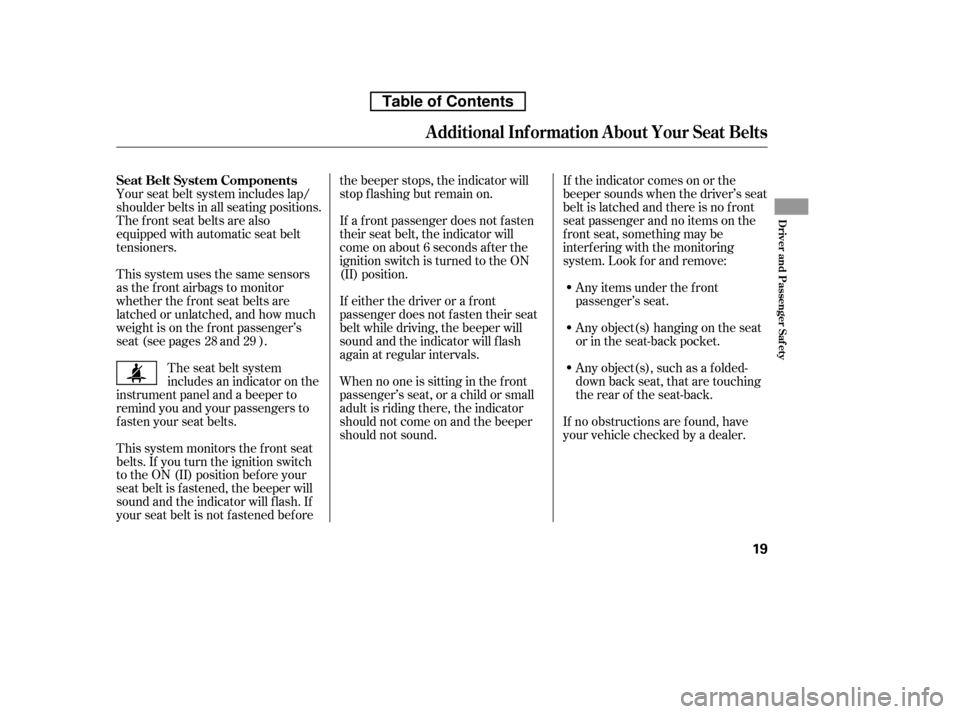
Your seat belt system includes lap/
shoulder belts in all seating positions.
The f ront seat belts are also
equipped with automatic seat belt
tensioners.
This system uses the same sensors
as the front airbags to monitor
whether the f ront seat belts are
latched or unlatched, and how much
weight is on the f ront passenger’s
seat (see pages and ).If the indicator comes on or the
beeper sounds when the driver’s seat
belt is latched and there is no f ront
seat passenger and no items on the
front seat, something may be
interf ering with the monitoring
system. Look f or and remove:
Any items under the f ront
passenger’s seat.
Any object(s) hanging on the seat
or in the seat-back pocket.
This system monitors the f ront seat
belts. If you turn the ignition switch
to the ON (II) position bef ore your
seat belt is f astened, the beeper will
sound and the indicator will f lash. If
your seat belt is not f astened bef ore the beeper stops, the indicator will
stop f lashing but remain on.
If a f ront passenger does not f asten
their seat belt, the indicator will
come on about 6 seconds af ter the
ignition switch is turned to the ON
(II) position.
If either the driver or a f ront
passenger does not f asten their seat
belt while driving, the beeper will
sound and the indicator will f lash
again at regular intervals.
When no one is sitting in the f ront
passenger’s seat, or a child or small
adult is riding there, the indicator
should not come on and the beeper
should not sound.
The seat belt system
includes an indicator on the
instrument panel and a beeper to
remind you and your passengers to
f asten your seat belts. If no obstructions are f ound, have
your vehicle checked by a dealer. Any object(s), such as a f olded-
down back seat, that are touching
the rear of the seat-back.
28 29
Seat Belt System Components
Additional Inf ormation About Your Seat Belts
Driver and Passenger Saf ety
19
Table of Contents
Page 38 of 441
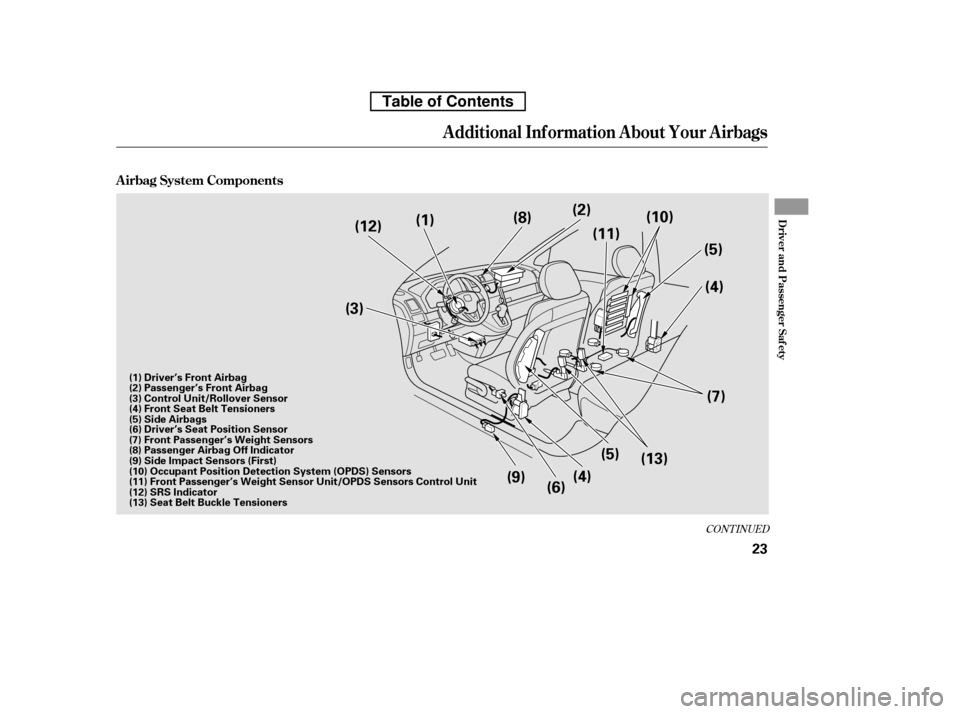
CONT INUED
A irbag System Components
Additional Inf ormation About Your Airbags
Driver and Passenger Saf ety
23
(1)(2)
(3)
(4)(5)
(6) (5)
(4)
(12)
(8)
(11)(10)
(7)
(13)
(9)
(1) Driver’s Front Airbag
(2) Passenger’s Front Airbag
(3) Control Unit/Rollover Sensor
(4) Front Seat Belt Tensioners
(5) Side Airbags
(6) Driver’s Seat Position Sensor
(7) Front Passenger’s Weight Sensors
(8) Passenger Airbag Off Indicator
(9) Side Impact Sensors (First)
(10) Occupant Position Detection System (OPDS) Sensors
(11) Front Passenger’s Weight Sensor Unit/OPDS Sensors Control Unit
(12) SRS Indicator
(13) Seat Belt Buckle Tensioners
Table of Contents
Page 40 of 441
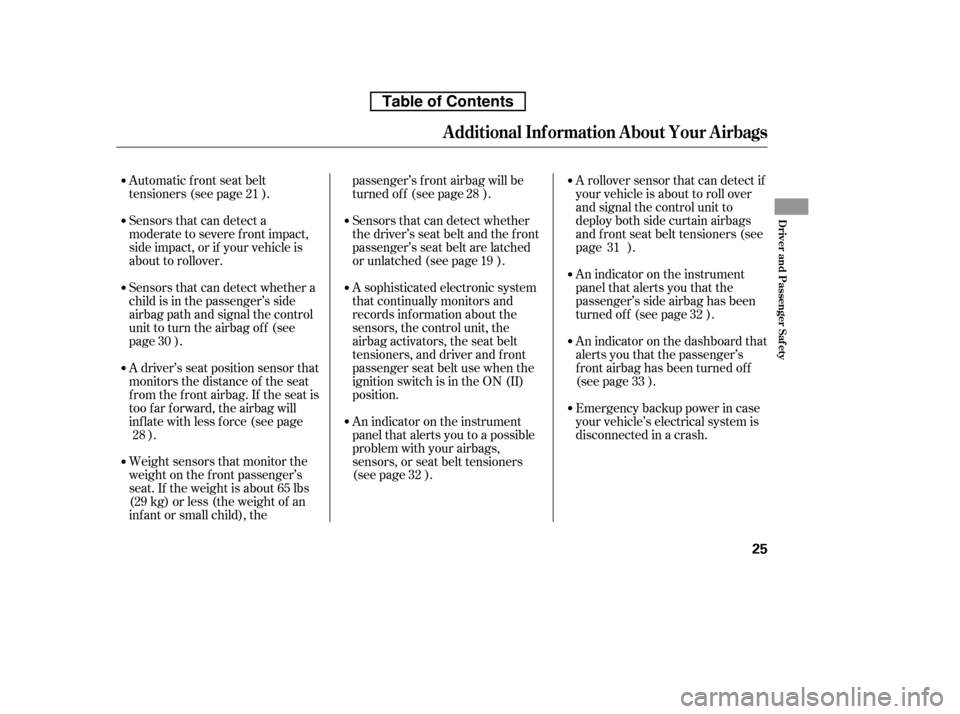
Automatic front seat belt
tensioners (see page ).A rollover sensor that can detect if
your vehicle is about to roll over
and signal the control unit to
deploy both side curtain airbags
and f ront seat belt tensioners (see
page ).
An indicator on the instrument
panel that alerts you that the
passenger’s side airbag has been
turned of f (see page ).
An indicator on the dashboard that
alerts you that the passenger’s
f ront airbag has been turned of f
(see page ).
Emergency backup power in case
your vehicle’s electrical system is
disconnected in a crash.
Sensors that can detect a
moderate to severe front impact,
side impact, or if your vehicle is
about to rollover.
Weight sensors that monitor the
weight on the f ront passenger’s
seat. If the weight is about 65 lbs
(29 kg) or less (the weight of an
inf ant or small child), the passenger’s f ront airbag will be
turned of f (see page ).
A driver’s seat position sensor that
monitors the distance of the seat
from the front airbag. If the seat is
too f ar f orward, the airbag will
inf late with less f orce (see page ).
Sensors that can detect whether a
child is in the passenger’s side
airbag path and signal the control
unit to turn the airbag of f (see
page ).
Sensors that can detect whether
the driver’s seat belt and the f ront
passenger’s seat belt are latched
or unlatched (see page ).
A sophisticated electronic system
that continually monitors and
records inf ormation about the
sensors, the control unit, the
airbag activators, the seat belt
tensioners, and driver and f ront
passenger seat belt use when the
ignition switch is in the ON (II)
position.
An indicator on the instrument
panel that alerts you to a possible
problem with your airbags,
sensors, or seat belt tensioners
(see page ).
21
30
28 28
19
32 31
32
33
Additional Inf ormation About Your Airbags
Driver and Passenger Saf ety
25
Table of Contents
Page 43 of 441

Your f ront airbags are also advanced
airbags. The main purpose of this
feature is to help prevent airbag-
caused injuries to short drivers and
children or small-statured adults who
ride in f ront.The driver’s advanced front airbag
system includes a seat position
sensor under the seat. If the seat is
too f ar f orward, the airbag will
inf late with less f orce, regardless of
the severity of the impact.
If there is a problem with the sensor,
the SRS indicator will come on, and
the airbag will inf late in the normal
manner regardless of the driver’s
seating position.The passenger’s advanced f ront
airbag system has weight sensors
under the seat. Although Honda
does not encourage carrying an
inf ant or small child in f ront, if the
sensors detect the weight of an
inf ant or small child (up to about 65
lbs or 29 kg), the system will
automatically turn the passenger’s
front airbag off.
Do not spill any liquids on or
under the seats, cover the sensors,
or put any objects or metal items
under the f ront seats.
Occupants must sit upright and
wear their seat belts properly.
For both advanced airbags to work
properly:
Failure to f ollow these instructions
could damage the sensors or prevent
them f rom working properly.
Advanced Airbags
Additional Inf ormation About Your Airbags
28
DRIVER’S
SEAT
POSITION
SENSOR
PASSENGER’S
SEAT WEIGHT
SENSORS
Table of Contents
Page 44 of 441
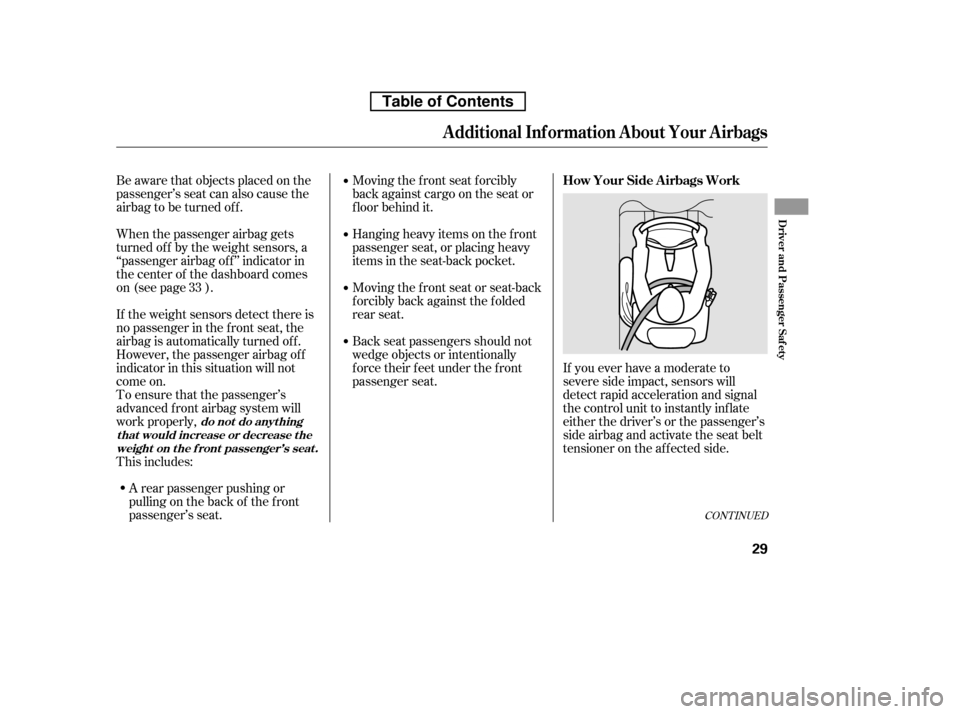
Moving the f ront seat f orcibly
back against cargo on the seat or
f loor behind it.
Hanging heavy items on the f ront
passenger seat, or placing heavy
items in the seat-back pocket.If you ever have a moderate to
severe side impact, sensors will
detect rapid acceleration and signal
the control unit to instantly inf late
either the driver’s or the passenger’s
side airbag and activate the seat belt
tensioner on the af f ected side.
When the passenger airbag gets
turned of f by the weight sensors, a
‘‘passenger airbag of f ’’ indicator in
the center of the dashboard comes
on (see page ).
Be aware that objects placed on the
passenger’s seat can also cause the
airbag to be turned of f .
Moving the front seat or seat-back
f orcibly back against the f olded
rear seat.
Back seat passengers should not
wedge objects or intentionally
f orce their f eet under the f ront
passenger seat.
A rear passenger pushing or
pulling on the back of the f ront
passenger’s seat.
To ensure that the passenger’s
advanced front airbag system will
work properly,
This includes:
If the weight sensors detect there is
no passenger in the f ront seat, the
airbag is automatically turned off.
However, the passenger airbag of f
indicator in this situation will not
come on.
33
CONT INUED
How Your Side A irbags Work
Additional Inf ormation About Your Airbags
do not do anyt hing
t hat would increase or decrease t he weight on t he f ront passenger’s seat .
Driver and Passenger Saf ety
29
Table of Contents
Page 48 of 441
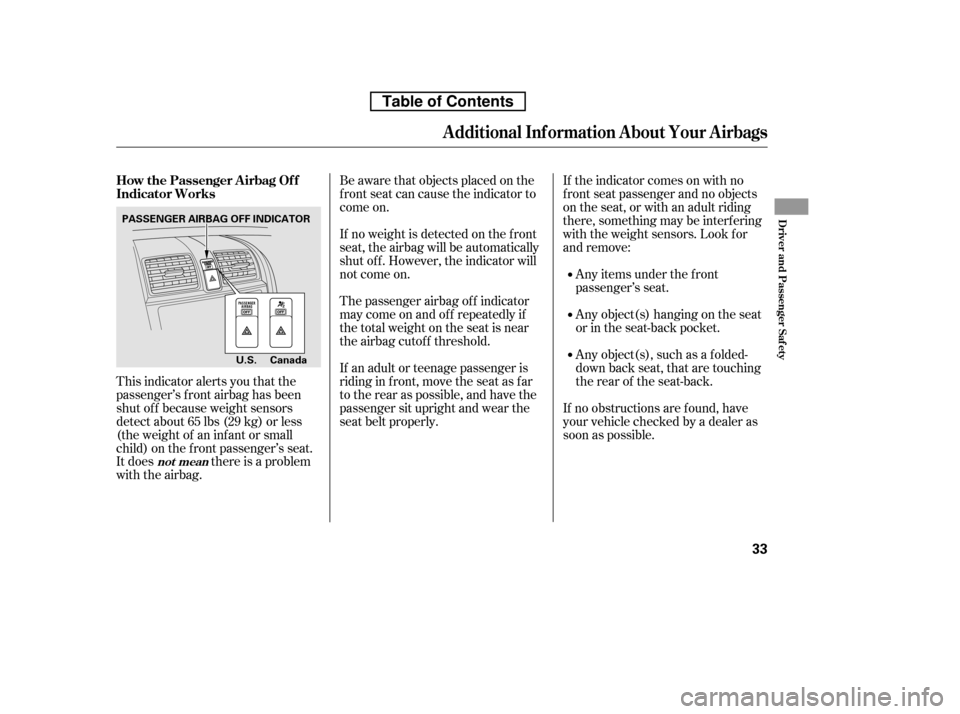
This indicator alerts you that the
passenger’s f ront airbag has been
shut of f because weight sensors
detect about 65 lbs (29 kg) or less
(the weight of an inf ant or small
child) on the f ront passenger’s seat.
It does there is a problem
with the airbag.Be aware that objects placed on the
f ront seat can cause the indicator to
come on.
If no weight is detected on the f ront
seat, the airbag will be automatically
shut of f . However, the indicator will
not come on.
The passenger airbag of f indicator
maycomeonandoff repeatedlyif
the total weight on the seat is near
the airbag cutof f threshold.
If the indicator comes on with no
f ront seat passenger and no objects
on the seat, or with an adult riding
there, something may be interf ering
with the weight sensors. Look f or
and remove:
Any items under the f ront
passenger’s seat.
Any object(s), such as a f olded-
down back seat, that are touching
the rear of the seat-back.
If no obstructions are f ound, have
your vehicle checked by a dealer as
soon as possible.
If an adult or teenage passenger is
riding in f ront, move the seat as f ar
to the rear as possible, and have the
passenger sit upright and wear the
seat belt properly. Any object(s) hanging on the seat
or in the seat-back pocket.
How the Passenger Airbag Of f
Indicator Works
not mean
Additional Inf ormation About Your Airbags
Driver and Passenger Saf ety
33
PASSENGER AIRBAG OFF INDICATOR
Canada
U.S.
Table of Contents
Page 49 of 441

If water or
another liquid soaks into a seat-
back, it can prevent the side airbag
cutof f system f rom working
properly.
Tampering could cause
the airbags to deploy, possibly
causing very serious injury. Together, airbags and
seat belts provide the best
protection. Even if your
airbags do not inflate, your dealer
should inspect the driver’s seat
position sensor, the f ront
passenger’s weight sensors, the
f ront seat belt tensioners, and all
seat belts and their anchors worn
during a crash to make sure they
are operating properly.
Your airbag systems are virtually
maintenance f ree, and there are no
parts you can saf ely service.
However, you must have your
vehicle serviced if:
Any airbag
that has deployed must be
replaced along with the control
unit and other related parts. Any
seat belt tensioner that activates
must also be replaced.
Do not try to remove or replace
anyairbagbyyourself.Thismust
be done by an authorized dealer or
a knowledgeable body shop.
Take your vehicle to an
authorized dealer as soon as
possible. If you ignore this
indication, your airbags may not
operate properly. This could make the
driver’s seat position sensor or the
f ront passenger’s weight sensors
inef f ective. If it is necessary to
remove or modif y a f ront seat to
accommodate a person with
disabilities, f irst contact Honda
Automobile Customer Service at
(800) 999-1009.
Do not expose t he f ront passenger’s
seat -back t o liquid.
Do not t amper wit h airbag component s or wiring f or anyreason.
Donotattempttodeactivateyour
airbags.
If your vehicle has a moderat e t o
severe impact .
An airbag ever inf lates.
T he SRS indicat or alert s you t o aproblem. Do not remove or modif y a f ront
seat wit hout consult ing your
dealer.
Additional Saf ety Precautions
Airbag Service
Additional Inf ormation About Your Airbags
34
Table of Contents
Page 55 of 441

Only a rear-f acing child seat provides
proper support f or a baby’s head,
neck, and back.
An inf ant must be properly
restrained in a rear-f acing, reclining
child seat until the child reaches the
seat maker’s weight or height limit
f or the seat, and the child is at least
one year old. Two types of seats may be used: a
seat designed exclusively f or inf ants,
or a convertible seat used in the rear-
f acing, reclining mode.
If placed
f acing f orward, an inf ant could be
very seriously injured during a
f rontal collision. A rear-f acing child seat can be placed
in any seating position in the back
seat, but not in the f ront.
If the passenger’s f ront airbag
inflates, it can hit the back of the
child seat with enough f orce to kill or
seriously injure an inf ant.
When properly installed, a rear-
f acing child seat may prevent the
driver or a f ront passenger f rom
moving their seat as far back as
recommended, or f rom locking their
seat-back in the desired position.
It could also interf ere with proper
operation of the passenger’s
advanced front airbag system.
Do not put a rear-f acing child seat in
a f orward-f acing position.
Child Seat T ype Rear-f acing Child Seat Placement
Never put a
rear-f acing child seat in t he f ront seat .
Protecting Inf ants
Protecting Inf ants and Small Children
40
Table of Contents